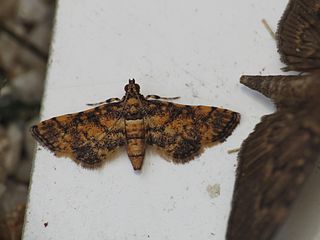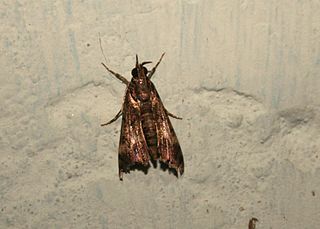
Hypena is a genus of moths in the family Erebidae. It was first described by Franz von Paula Schrank in 1802. These non-migratory moths overwinter as pupae and almost never estivate as adults.

The brown-dotted clothes moth is a species of tineoid moth. It belongs to the fungus moth family (Tineidae), and therein to the nominate subfamily Tineinae. It is the type species of its genus Niditinea.

Nacoleia rhoeoalis is a species of moth of the family Crambidae. It is found in New South Wales, Queensland, Victoria, Western Australia and Tasmania. The species was first described by Francis Walker in 1859.
Luceria is a genus of moths of the family Erebidae. It was described by Francis Walker in 1859. This genus is found in southern Asia, Australia, on several Pacific islands and a few species also in Africa.

Poliobotys is a monotypic moth genus of the family Crambidae described by Jay C. Shaffer and Eugene G. Munroe in 2007. Its single species, Poliobotys ablactalis, was described by Francis Walker in 1859. It occurs throughout South-east Asia, including Réunion, Australia, Hong Kong and Africa.

Glyphodes negatalis, the karanj defoliator, is a moth of the family Crambidae. The species was first described by Francis Walker in 1859. It has a wide range in the tropics, including South Africa, The Gambia, Mali, India, Sri Lanka, Hong Kong, Japan, and eastern Australia.

Bradina admixtalis is a species of moth of the family Crambidae described by Francis Walker in 1859. It is found in Australia, New Guinea, New Zealand, south-east Asia and the Comoros, Réunion, South Africa as well as India.

Gesonia obeditalis is a species of moth of the family Noctuidae first described by Francis Walker in 1859. It is found from eastern Africa, the Seychelles, the Maldives and the Oriental tropics of India, Myanmar, Sri Lanka east to the Philippines, the Sula Islands and Australia. The adult moth has brown wings with a scalloped dark brown band near the margin. The hindwings are similar in pattern to the forewings but are a paler shade of brown.

Metasia tiasalis is a species of moth of the family Crambidae.
Elusa ceneusalis is a species of moth of the family Noctuidae. It was described by Francis Walker in 1859 and is known from Sundaland, the Philippines, Sulawesi, Queensland, and the Bismarck Islands.

Orphanostigma abruptalis is a moth of the family Crambidae. The species was first described by Francis Walker in 1859. It occurs in the tropics of the Old World from Africa to Australia.

Noorda blitealis is a species of moth of the family Crambidae. It is found in subtropical Africa, south of the Sahara and in Australasia.

Banisia myrsusalis, the sapodilla borer or sapota midrib folder, is a species of moth of the family Thyrididae. It was described by Francis Walker in 1859 and is found in North America, Brazil, Australia, southern Asia and Africa.

Agrioglypta eurytusalis is a moth in the family Crambidae described by Francis Walker in 1859. It is found in southern India, Sri Lanka, Borneo, Cambodia, Thailand, Taiwan, Japan and Australia, where it has been recorded from northern Queensland.
Agrioglypta excelsalis is a moth in the family Crambidae described by Francis Walker in 1866. It is found on Sulawesi, Lifou Island, as well as in Bhutan, Thailand, Sumatra, Papua New Guinea, Samoa and in Australia, where it has been Western Australia, Queensland and northern New South Wales.

Nacoleia charesalis is a moth in the family Crambidae. It was described by Francis Walker in 1859. It is found in Australia, India, Sri Lanka, Borneo, Sumbawa, the Philippines, Singapore, Thailand, Japan, Taiwan and on the Seychelles.
Pardomima amyntusalis is a moth in the family Crambidae. It was described by Francis Walker in 1859. It is found in the Democratic Republic of the Congo, Ivory Coast, Kenya, Madagascar, Mozambique, Sierra Leone, Uganda, Zambia, Sri Lanka, India, Indonesia (Java), Myanmar and Australia, where it has been recorded from Western Australia.
Brana is a monotypic moth genus of the family Noctuidae. Its only species, Brana calopasa, is found in Sri Lanka and Australia. Both the genus and species were described by Francis Walker, the genus in 1858 and the species in 1859. It It is a serious pest on Berrya cordifolia.
Hypena mandatalis, is a moth of the family Erebidae first described by Francis Walker in 1859. It is found in the Indian subregion, Pakistan, Sri Lanka, Borneo, Sulawesi and Australia.

Margaroniini is a tribe of the species-rich subfamily Spilomelinae in the pyraloid moth family Crambidae. The tribe was erected by Charles Swinhoe and Everard Charles Cotes in 1889, originally as family Margaronidae.














